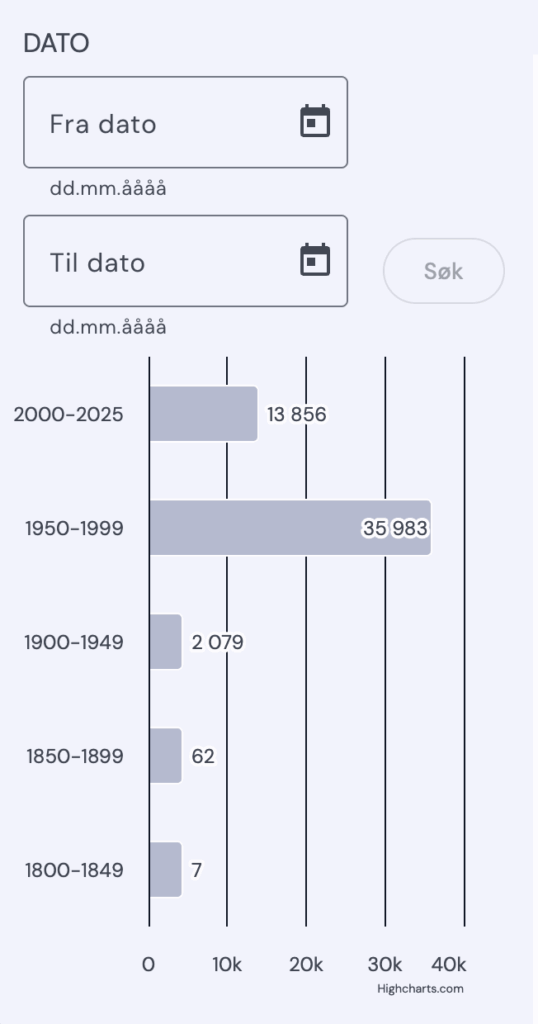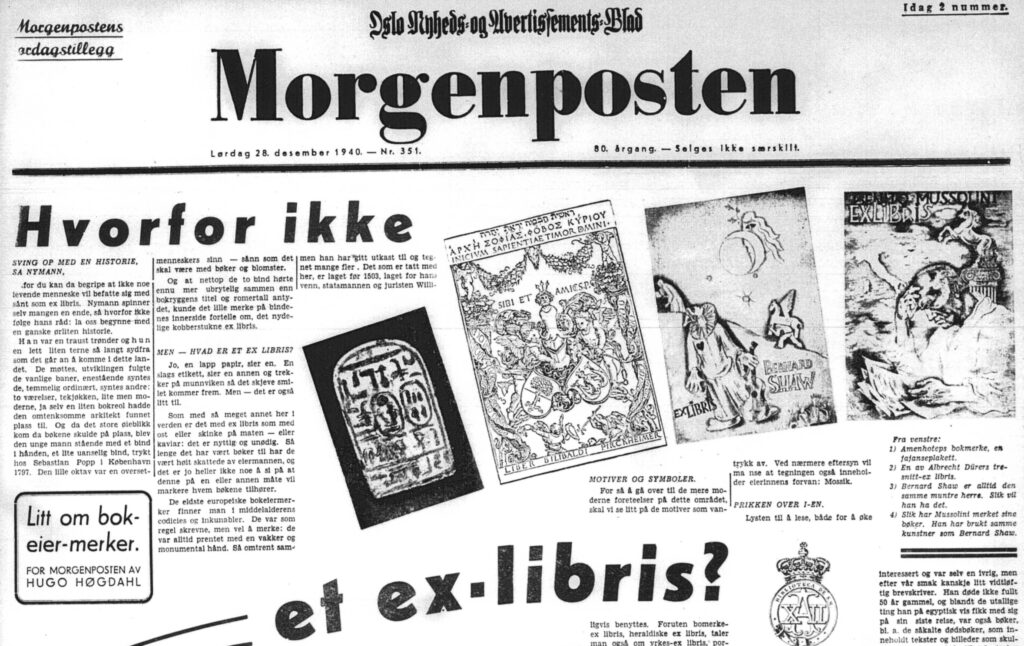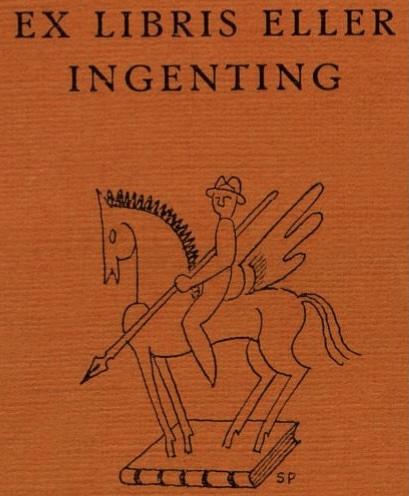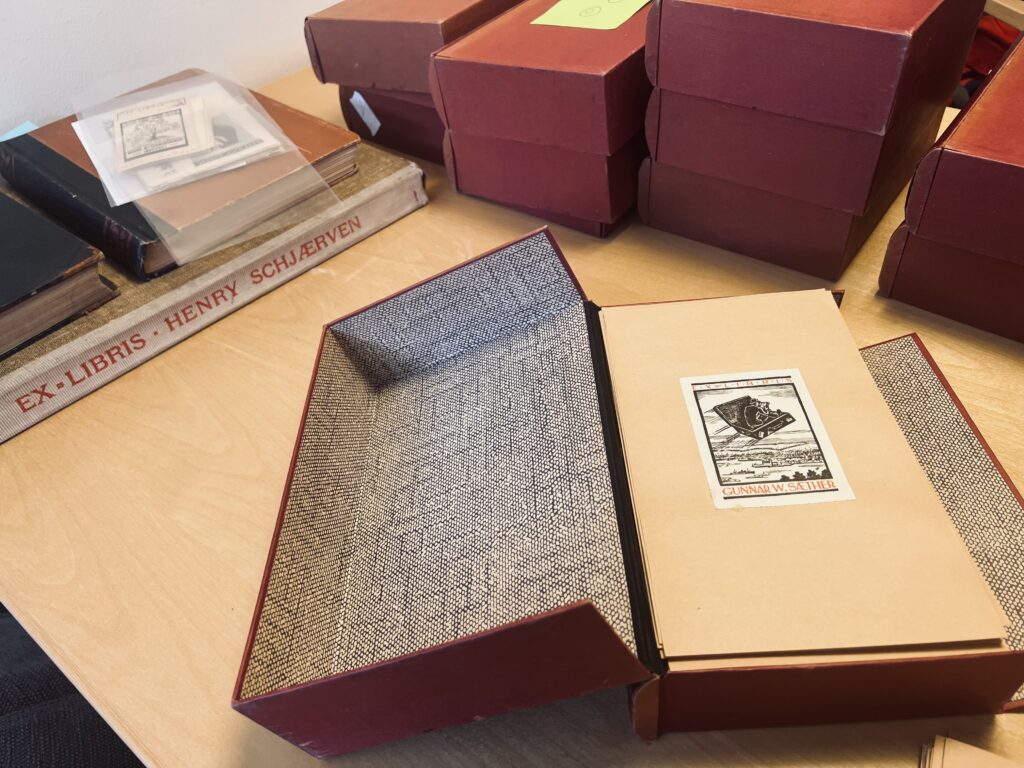The Newspapers Shout It! And Who Is Listening?
We looked into the early publications about the Norwegian exlibris in the last three blog posts – the exhaustive catalogue of exlibris and exlibris literature from the 1970s, the Exlibris. – or Nothing articles and collector’s editions by Hugo Høgdahl from 1937, 1941 and 1942, and the suggestive “Why not an exlibris?” one pager by Hugo Høgdahl from 1940 and its reprints from 1941 and 1942.
However, the tracking and tracing of newspaper and magazine articles – a curious place for writing and reading about exlibris, I believed – has led me down a deep rabbit hole.
Schyberg’s Norsk Exlibrisiana (1975), my starting point for researching exlibris from the first half of the 20th century, provides a chronological overview of articles, reviews, notes, and advertisements in the daily press (part 3), on pages 18–39, starting in 1927.
Checking References
I set out to verify each entry and then added it to the Zotero library. And I quickly realised that the entries were incorrect.
A very typical error, when creating bibliographies, is mistyping or jumbling the numbers in dates. Which makes it very hard to find a particular article in the sea of newspapers, which are rarely indexed on the article level.
I didn’t make it further than 1928 in the bibliography of Norsk Exlibrisiana, when I decided to instead of trying to find the listed items (and potentially correct them or do some creative search), I would create a completely new bibliography of exlibrisiana in the Norwegian daily press, making use of the mass digitisation conducted industry-style at the Norwegian National Library.
The National Library has come far along with digitising their entire newspaper collection, and all papers are full text searchable. I started looking for articles which contain the keyword(s) ex libris and the sheer amount of hits was overwhelming!
I made the decision to narrow down my search and make it easier to check the hits for content and then decide whether or not to include an article in the bibliography: just by retrieving a hit for ex libris, an article isn’t necessarily qualified to be included in the list. Only if it is about a particular exlibris or about exlibris in general or related material, I will include it.
The Boon and Bane of Mass Digitisation
The sun of mass digitisation throws long shadows, though. I quickly understood that the OCR (optical character recognition) of the newspapers is sub-optimal, and in quite a few instances outright abysmal. Looking for the key phrase ex libris would retrieve only a small percentage of articles about exlibris.
I cannot explain why exactly, but it looks like from what I have observed, that the Latin preposition ex appears too often in the texts for not being a commonly used Norwegian particle (Norwegian doesn’t have the letter x but uses the phonetic equivalent ks instead. The letter x is only kept in foreign, mainly Latin, words and names). It seems that it ex in the corpus of digitised newspapers often is a misread er (the conjugated present tense of Norwegian verb å være, to be) or et (neutral form of the Norwegian indefinite article a/an): both words that appear at a high frequency.
The other issue is that the word libris (which is also not a Norwegian word and only found as a Latin foreign word), is quite often misread by the OCR, but not producing an actual, false reading but plain gibberish, with no recognisable pattern.
I cannot use the phrase ex libris to dependably identify all appearances, but instead have to do a two-step search with a high amount of manual checking. I went on to search firstly for ex in a selected newspaper (like the notoriusly badly OCR-recognised Aftenposten) and limiting the corpus to span one year at a time and retrieve all hits. I then manually go through the keyword-in-context tiles and check if the word(s) following ex are libris or a character string that could visually resemble libris. Since I can at a glance check the provided context for other clues, I have a high chance of correctly identifying exlibris-related material.
However, there is a chance that this search will miss some occurences, mainly those where the Latin ex is misread by the OCR as Norwegian words er or et – which happens – so I have to double-check by using the search term libris on its own. This sometimes retrieves previously missed articles.
I have, however, no systematic way of catching articles where both words of the keyword search ex libris are misread; there are simply too many possible variations and due to the bad OCR, I would get an insurmountable pile of false positives I would have to go through manually. So, I decided to cut my losses and aim for catching all articles in especially badly recognised newspapers with the method of looking for ex first, and double-checking with libris a second time. The rest may stay hidden.
How You Search Constrains What You Find
It is important to be aware of how we search in a corpus like the National Library’s digitised full-text newspapers: The search modus on nb.no is free text search. You put a word, a number, or a string and you get all hits that match that word, number, or string. When it comes to strings, you need to be careful, though. If you look for a specific phrase, like ex libris (two words with a space in between), you have to start and end the phrase with double quotation marks, i.e. "ex libris": the search engine will then look for all occurrences for exactly this sequence of characters. When we do that for the entire corpus of digitised newspapers, we get 17.398 hits for the exact phrase.
However, this approach will not catch all articles, mainly due to the high error rate in the OCR, but also because the spelling of exlibris in Norwegian texts of the time is under-regulated. I have observed these variations: ex-libris, ex libris, eks libris, exlibris so far.
If I search for ex libris without the double quotation marks, the search engine instead will look for all occurrences where both the word ex and the word libris occur in the same newspaper issue. This will sometimes retrieve a false positive: some places, the word ex is used, and somewhere else, unrelated, the word libris. From my observation, this happens rarely, though.
It will, on the other hand, catch more positive hits; we already know that the latin word libris is quite often misread by the OCR, while the latin preposition ex is often a misread Norwegian verb er or indefinite article et. However, I have observed that most newspaper articles about exlibris will repeat the phrase ex libris (or the above mentioned variations) twice or more throughout the text and this increases the chances of getting a positive hit even when one or more occurrences of libris are misread; the same goes for misread ex.
When I do an simple search for ex libris, I get 51.987 hits for the entire newspaper corpus (figure 1). That is a massive amount. I can use the nb.no filter function and investigate the frequency of hits by date. Here I can see that the overwhelming amount of hits lie in the period 1950–1999: 35.983. Another 13.856 are hits in the period 2000–2025. I know from other online searches for Norwegian exlibris that most hits on the Norwegian Internet will retrieve books from the publishing house Ex libris, founded in 1982 and merged with N. W. Damm & Søn in 2000. So, I suspect that most hits from the period 1982 until 2000 will be for said publishing house, and not for exlibris as in: bookplate.

ex libris in the digitised daily press corpus of the National Library of Norway. The search was performed on 23rd November 2025 from an IP address in Norway. The distribution shows matches for the phrase by 50-year increments, starting in 1800 and ending in 2025, i.e. the entire corpus. For the period 1800–1849, there are a mere 7 hits. For 1850-1899, 62 hits match the keyword search. A signifiant increase in hits is observable for the period 1900-1949, with 2.079 hits. The hit rate increases manyfold in the period 1950-1999, with two thirds of all hits, 25.983. In the last period, which only covers 26 years (200–2025), the hit rate drops but is still high at 13.856 hits.
ex libris by 5-year increments. While there are similar hit rates in the years between 1950 and 1974 (between 100–200), the number drastically increases from 1980 onwards and peaks with another massive increase in the period between 1990–1999. This might be due to the mention of the publishing house Ex Libris and/or publications by Ex Libris.When we take a closer look at the distribution of hits by 5-year increments, the suspicion that the mention of the publishing house Ex Libris is creating the ‘false’ hits is reinforced: The majority of hits for ex libris lies in the years 1985 to 1999.
I haven’t yet sampled the hits for the period after 1950 – this will be the work for another time. However, and unlike what I first believed to be the case, there is a continuous discourse around the exlibris and its function as a book owner’s mark or identifier. It is wide-spread, and with varying frequency, present in all national, regional, and political outlets of the daily press. It features mostly in the context of culture, in commentary and the feuilleton as well as weekly supplements and weekend issues.
Copious Amounts
A day or two into my search, it dawned on me that there were not just a few more articles hidden in the thousands and thousands of newspaper pages, but an incredible amount of them!
I had started with Aftenposten, during the period of interest (1920-1950), the largest Norwegian newspaper, which also continued to publish during the Occupation 1940–1945. In Aftenposten alone, between 1927 and 1943, i could identify 220 articles. Some of these really only mention exlibris in passing, and will not make it into the final bibliography, but the vast majority are!
This was so unexpected, that I had to rethink my approach and how I had hypothesised about the 1940s exlibris craze in Norway. The explosion of exlibris making and exlibris activities like exhibitions, portfolio publications, collections, and the founding of the exlibris “club”, which I believed to have started suddenly and intensely, seems to have had a much longer preface, with regular activity and media presence throughout the 1930s in the daily press.
Collection Bias
It is perhaps most interesting for me to see where my collection (i.e. previously the collection of Rolf Nysted Heier, a contemporary of the rise and fall of the Norwegian exlibris in the middle of the 20th century) is biased. These weekly articles about exlibris, that create the backdrop for Nysted Heier and his fellow Exlibris enthusiasts’ and collectors’ makings and doings, did not make it into the collection. I cannot know for sure if Nysted Heier read them, but I assume he read one – or even more – daily newspapers regularly and was a witness to the public discourse about the exlibris.
I have now gone through 17 years of Aftenposten (1927–1943) and 47 years of Morgenbladet (1896–1943) and have identified over 300 articles. According to Norgeshistorie.no, there were about 260 newspapers in Norway before the Nazi-German Occupation in 1940. Their number was more than halfed by 1945, when Nazi Germany surrendered and WWII and the Occupation of Norway ended. Still, this is an incredible amout of daily press, given Norway only had a little under 3 million citizens during the first half of the 20th century.
One Message – Many Channels
A brief check of one year only, 1937, with all digitised newspapers on nb.no and the full search phrase “ex libris” retrieved already 72 hits in papers from all over Norway.
Considering the limitations of searching in the digitised corpus, I cannot manage to do my manual result checking with the sole search term “ex” for the amount of newspapers which might have articles. As it looks right now, most of the regional and local newspapers seem to copy content from the major, national, daily newspapers. I will do some random sampling from the political newspapers, like Arbeidet, if they have exlibris content different from what the main news outlets produce.
I think I will not go through the smaller, regional newspapers systematically, but rather do some targeted deep-dives into newspapers from those regions where I know productive exlibris artists or collectors lived and worked.
Another thing: we already know, because it was reiterated in almost all of the later exlibris publications, that Oslo and Bergen were the epicentres of exlbiris activity. Thus, it seems natural to look there, first and foremost.
A Necessary Interruption
I feel that I cannot really call this blog post a part of the series – I had no object representing daily press in my talk and said very little about newspapers because I knew nothing about the omnipresence of the exlibris there and in magazines.
Instead, I will use this post as an intermezzo, a short piece where I write about what happens when one dives into the sea of mass digitisation of cultural heritage and finds treasure a bit too heavy to lift in one go.
Below, you can see a selection of the newspaper titles where I have confirmed exlibris articles; most are from 1937. It may serve as a visual impression of the bountiful pre-war Norwegian daily press that considered exlibris a worthwhile subject.

Cut-out from the front page, with newspaper title, date, and advertisements.
Source: National Library of Norway

Cut-out from the front page, with newspaper title, date, and advertisements.
Source: National Library of Norway

Cut-out from the front page, with newspaper title, date, and advertisements.
Source: National Library of Norway

Cut-out from the front page, with newspaper title, date, and advertisements.
Source: National Library of Norway

Cut-out from the front page, with newspaper title, date, and advertisements.
Source: National Library of Norway

Cut-out from the front page, with newspaper title, date, and advertisements.
Source: National Library of Norway

Cut-out from the front page, with newspaper title, date, and advertisements.
Source: National Library of Norway

Cut-out from the front page, with newspaper title, date, and advertisements.
Source: National Library of Norway

Cut-out from the front page, with newspaper title, date, and advertisements.
Source: National Library of Norway




One Comment
Comments are closed.